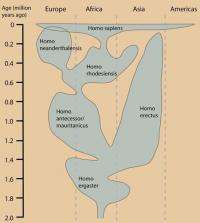January 21, 2010 report
Humans were once an endangered species

(PhysOrg.com) -- Scientists from the University of Utah in Salt Lake City in the U.S. have calculated that 1.2 million years ago, at a time when our ancestors were spreading through Africa, Europe and Asia, there were probably only around 18,500 individuals capable of breeding (and no more than 26,000). This made them an endangered species with a smaller population than today’s species such as gorillas (approximately 25,000 breeding individuals) and chimpanzees (an estimated 21,000). They remained an endangered species for around one million years.
Modern humans are known to have less genetic variation than other living primates, even though our current population is many orders of magnitude greater. Researchers studying specific genetic lineages have proposed a number of explanations for this, such as recent "bottlenecks", which are events in which a significant proportion of the population is killed or prevented from reproducing. One such event was the Toba super-volcano in Indonesia that erupted around 70,000 years ago, triggering a nuclear winter. Only an estimated 15,000 humans are thought to have survived. Another explanation is that the numbers of humans and our ancestors were chronically low throughout the last two million years, sometimes with only 10,000 breeding individuals surviving.
The new research is concerned with the entire genome rather than specific genetic lineages studied in the earlier research work. Using a new method of studying genetic markers of DNA in the genome has allowed geneticists to study the genetics not only modern humans, but also our early ancestors such as Homo erectus (thought the most likely to be our direct ancestors), H. ergaster and archaic H. sapiens. Remarkably, they found there was enough information in only two human DNA sequences to estimate the ancient population size.
Human geneticist Lynn B. Jorde and colleagues studied parts of the genome containing mobile elements called Alu sequences, which are sections of DNA around 300 base-pairs long that randomly insert themselves into the genome. This is a rare occurrence, but once inserted, they tend to stay in place over generations, and act as markers, rather like fossils, for ancient parts of the genome. On average, regions containing Alu insertions are older than other regions, and because they are old these regions have been shaped more by the forces that applied to ancient populations than to recent bottlenecks (such as Toba) and expansions.
The researchers studied mutations in the DNA near these Alu markers in two modern human genomes that have been completely sequenced. Older regions containing Alu sequences have more mutations because they have been in existence longer, and the researchers used the nucleotide diversity to estimate the age of the region of the genome. They then compared these regions with the overall diversity in the two genomes to estimate the differences in effective population size, and thus the genetic diversity between modern humans and our ancestors.
From these studies, they calculated there was more genetic diversity in our early ancestors than there is in modern humans. They also came to the conclusion that there had been a catastrophic event around one million years ago that was at least as devastating as the Toba volcanic eruption, and which had almost wiped out the species.
Jorde said that humans and our ancestors have gone through cycles of large population size and also periods when we were endangered. Professor Jorde and his team’s findings were reported online in PNAS, the Proceedings of the National Academy of Sciences on January 19.
More information: Mobile elements reveal small population size in the ancient ancestors of Homo sapiens, PNAS, DOI:10.1073/pnas.0909000107
© 2010 PhysOrg.com

















